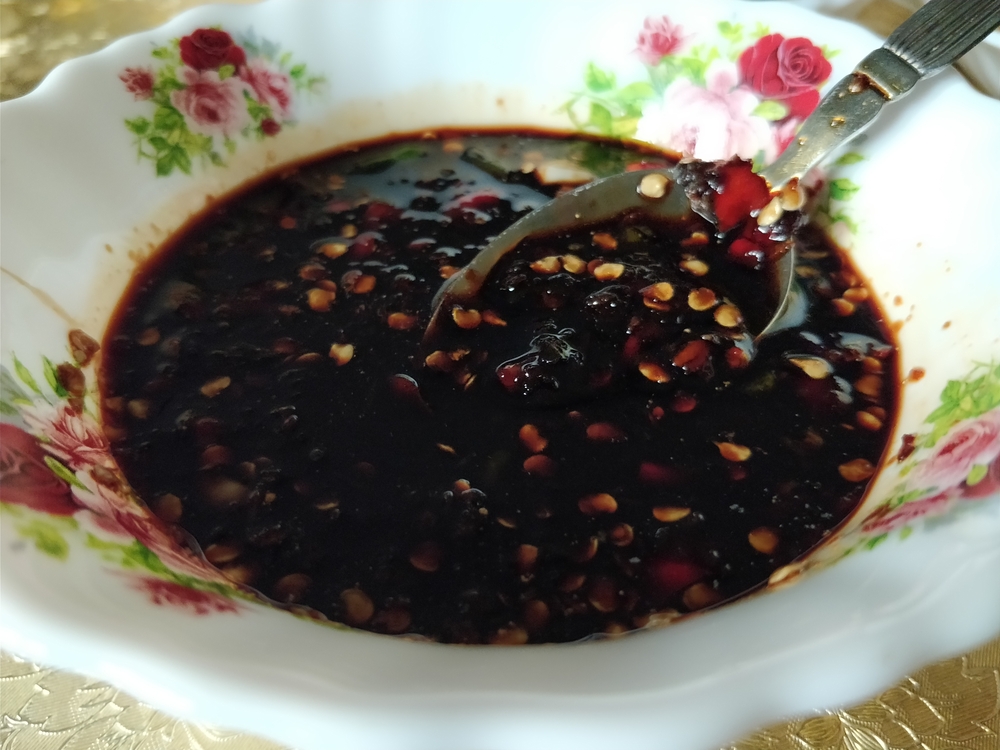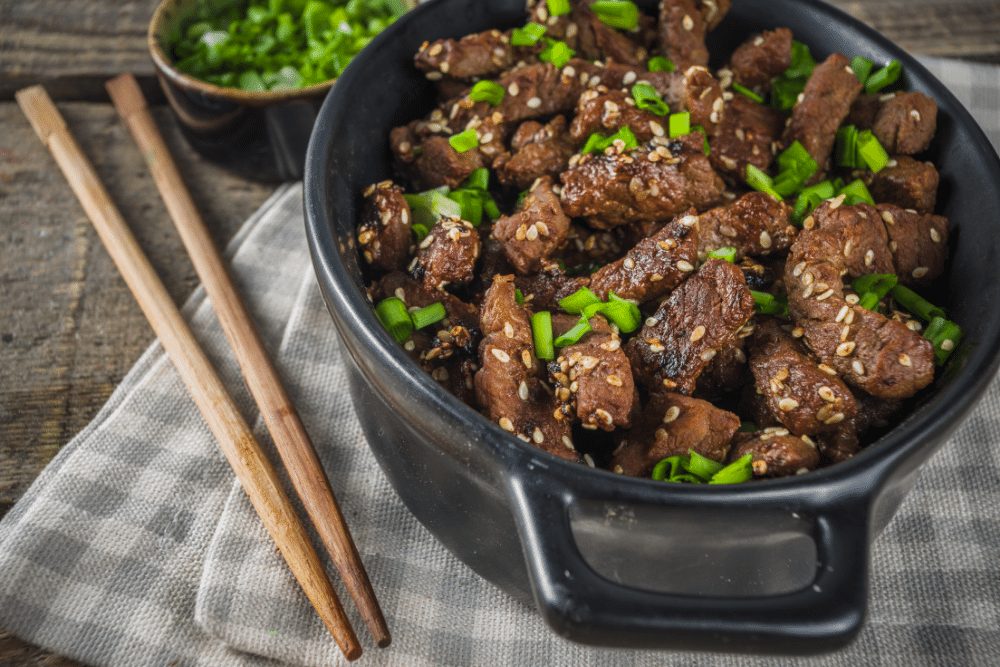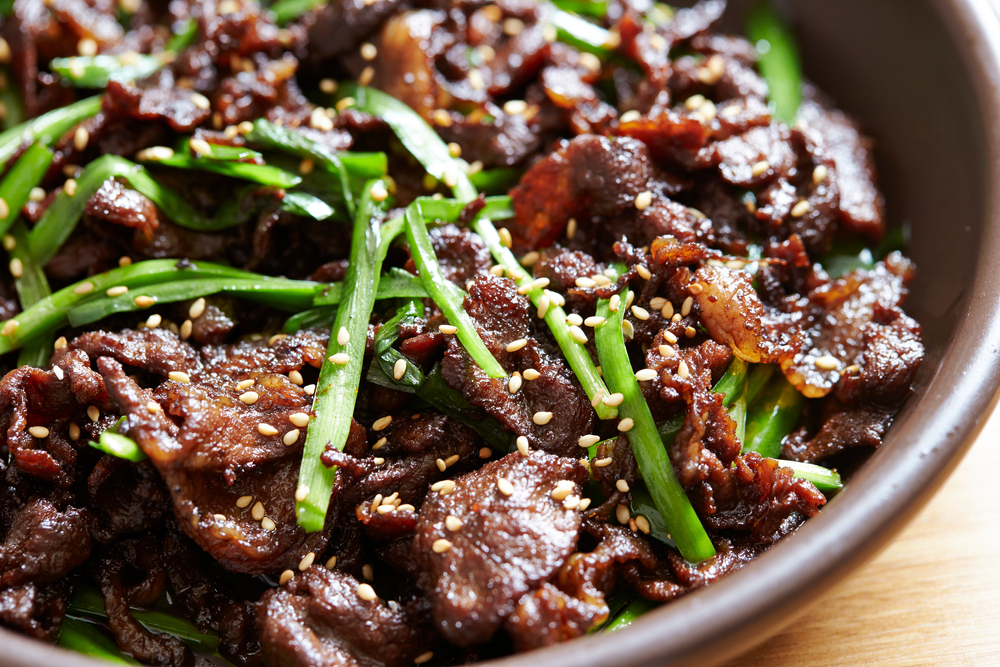Bulgogi sauce is a sweet and spicy all-purpose marinade traditionally used to flavor and tenderize beef before grilling or stir-frying. You can buy bulgogi sauce in stores or make your own to control the heat level and ingredients.
What’s Bulgogi Sauce Made Of?
Bulgogi sauce is a sweet and spicy marinade made with soy sauce, chili paste, brown sugar and other ingredients.
The whole list of ingredients and their substitutes includes:
- (Low-sodium) soy sauce, preferably Korean soy sauce, which is gluten-free as it contains no wheat, unlike Chinese soy sauce.
- Asian pear juice or grated pear fruits (substitute with apple juice, applesauce, pureed kiwifruit, a dash of cola, grated nashi pear, minced onion, or grated apple).
- Gochujang sauce/paste (a popular Korean fermented chili paste made with gochugaru).
- Rice vinegar/rice wine vinegar (some substitute with apple cider vinegar).
- Sesame oil (substitute with neutral vegetable oil, but you’ll forego the nutty flavor).
- Toasted or untoasted sesame seeds – optional
- Brown sugar or honey (substitute maple syrup, honey or agave, but it will change the flavor slightly).
- Freshly grated or chopped ginger (powdered ginger can be used in a pinch, but it really does not impart the same taste).
- Minced garlic.
- Hot peppers, such as black pepper and red pepper flakes (add one red pepper if you want your sauce hotter) – optional.
- Scallion/green onions, finely chopped (substitute with chives or leeks, preferably the white parts, or finely minced white onion).
- Water.

What Does Bulgogi Sauce Taste Like?
Bulgogi sauce is a delicate balance of complex smoky and tangy flavors.
It has hints of the following flavors from different ingredients:
- Spiciness from chili sauce, ginger, and hot peppers.
- Molasses flavor from brown sugar (this goes away if you use granulated sugar as a substitute).
- Nutty, earthy flavor from sesame oil and sesame seeds.
- Sweet flavor from brown sugar/maple syrup/honey.
- Fruity flavor from fruit juice/grated fruit.
- Umami flavor from soy sauce
- Sourness and tangy flavor from rice vinegar.
- Saltiness that balances the sweetness of fruit juice.
- Garlic and ginger.
How Spicy Is Bulgogi Sauce?
The spiciness of bulgogi sauce varies depending on how it is made. Variations of bulgogi sauce recipes are rampant. Even bulgogi sauce bought from the store will have varying levels of spiciness, depending on the brand. Some don’t contain any chili at all.
If you make your own bulgogi sauce at home, you’ll have more control over the ingredients and spice levels. One way to make the sauce spicier is to use more gochujang sauce or hot peppers, like Thai chili peppers.
Is Bulgogi Sauce The Same As Korean BBQ Sauce?
Bulgogi sauce isn’t the same as Korean BBQ sauce, even though the two are usually used synonymously.
Korean barbecue sauce is an umbrella term for all Korean sauces used with barbecues, like beef, pork, and chicken. As such, bulgogi sauce is a Korean barbecue sauce, but not every Korean BBQ sauce is bulgogi.
For example, Kalbi or Galbi sauce is another popular Korean barbecue sauce with some of the ingredients featured in bulgogi sauce, including soy sauce, garlic, rice vinegar, ginger, and sugar.
How To Use Bulgogi Sauce
The one thing you’ll love about bulgogi sauce apart from its delicacy is its versatility. You can use it as a marinade or sauce in many ways.
- Marinating cuts of beef. Beef bulgogi is by far the most popular Korean barbeque dish. Good cuts to use include ribeye, skirt steak, sirloin steak, short rib, New York strip streak, and flank steak.
- Marinating other proteins like chicken and pork are also highly popular in Korean restaurants.
- Slathering or brushing on chops and burgers.
- Drizzling on meals such as noodles and rice.
- As a cooking sauce or marinade for Korean bulgogi-style bean curd or fried tofu. (Here’s a bulgogi-style tofu recipe you can serve with fluffy white rice, char-grilled Pak Choi, or steamed broccoli).
- As a substitute for unagi sauce, Kalbi sauce, and Japanese teriyaki sauce.
- As a glaze for grilled mushrooms, various stir-fries, and salmon, or as a stir-fry sauce for beef or chicken.
- As a dipping sauce (when made thicker) for sweet potato fries, lettuce wraps, and zucchini fries.
- As a dressing for roasted or raw veggies.

What Can I Use If I Don’t Have Bulgogi Sauce?
If you don’t have bulgogi sauce, you can use any other Korean barbecue sauce, such as Kalbi sauce.
Kalbi sauce won’t be as powerful, but it will be spicier and have a sweet undertone that results in a deliciously complex flavor profile similar to bulgogi sauce.
Japanese teriyaki sauce also works as a bulgogi substitute if you want some subtle sourness in your meals.
Use unagi sauce to replace bulgogi sauce if you want a sauce with a thicker texture.
Other suitable bulgogi sauce substitutes include ponzu sauce for some tartness, hoisin sauce for extra tanginess and sweetness, coconut aminos, soy sauce, and Worcestershire sauce.
Is Bulgogi Sauce Gluten Free?
Traditional bulgogi sauce isn’t gluten-free if you use Chinese soy sauce. To make gluten-free bulgogi sauce, you’ll have to use gluten-free Japanese Tamari or gluten-free soy sauce.
Your homemade bulgogi sauce can be gluten-free from the start if you use Korean soy sauce rather than Chinese soy sauces. Korean soy sauce features water, soybeans, and salt. It has no wheat.
Where To Buy Bulgogi Sauce
Bulgogi sauce is available in grocery stores or supermarkets in the Asian or International cuisine section. You can also find it in the Korean aisles of Asian import stores.
If you prefer shopping online, you can buy bulgogi sauce from Amazon, Yin Yam, or YamiBuy.
How To Make Bulgogi Sauce
Making your own bulgogi sauce at home is easy once you have all the primary ingredients or their substitutes.
There are two ways of making the sauce, depending on the desired consistency.
How To Make Bulgogi Sauce By Whisking
Whisk all the ingredients together (including water) in a bowl until they are evenly mixed. You can puree them in a blender instead to achieve a smoother consistency.
How To Make Bulgogi Sauce By Heating
It isn’t really necessary to heat any of the ingredients for making Korean bulgogi sauce, but this method results in a thicker sauce that makes a nice condiment by reducing the liquid with heat.
You can follow the three recipes below to make bulgogi sauce and bulgogi beef:
- Bulgogi recipe (and beef bulgogi) courtesy of Allrecipes.com
- Bulgogi Korean BBQ beef courtesy of Food Network
- Bulgogi beef recipe courtesy of Food Network

